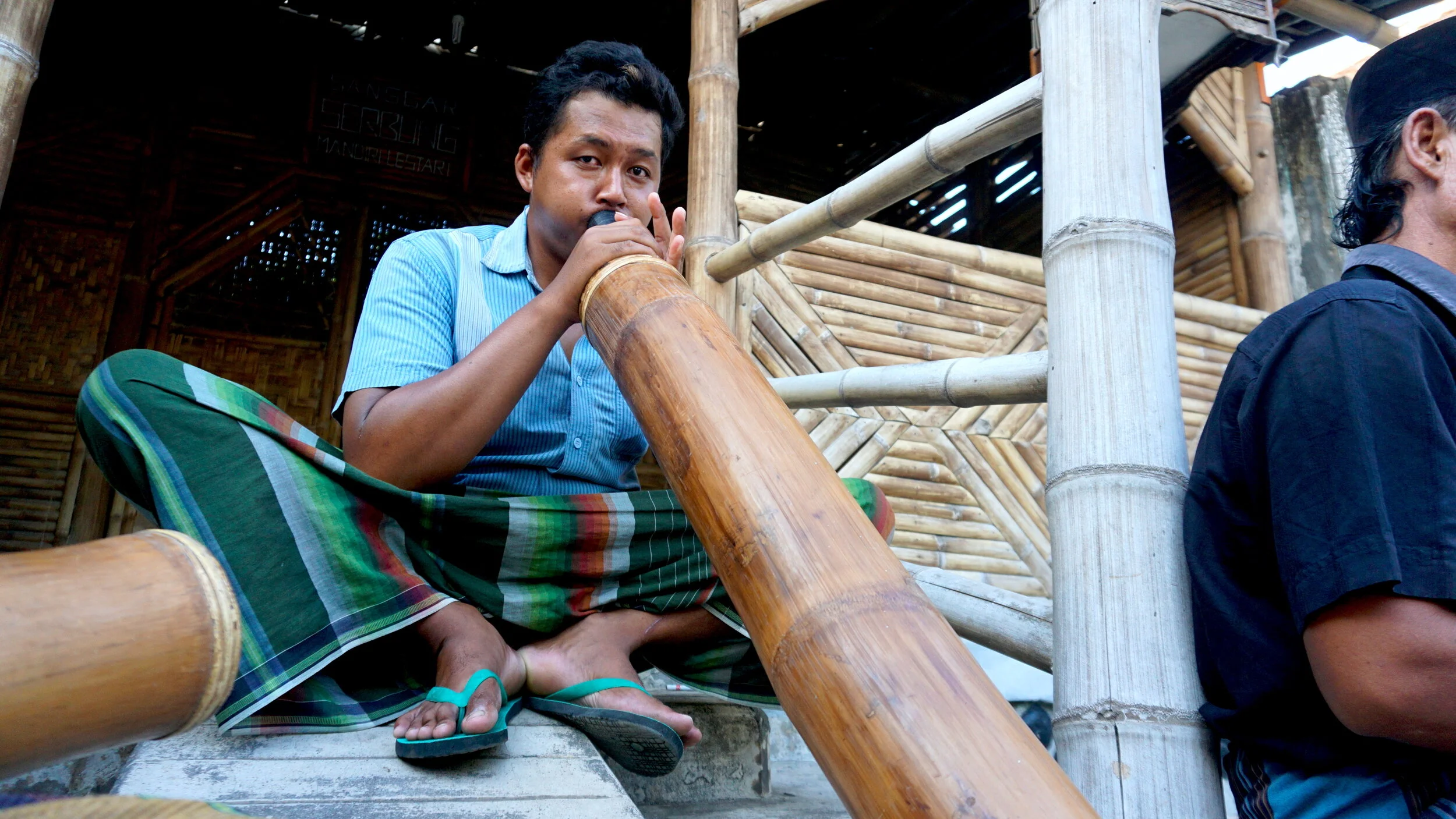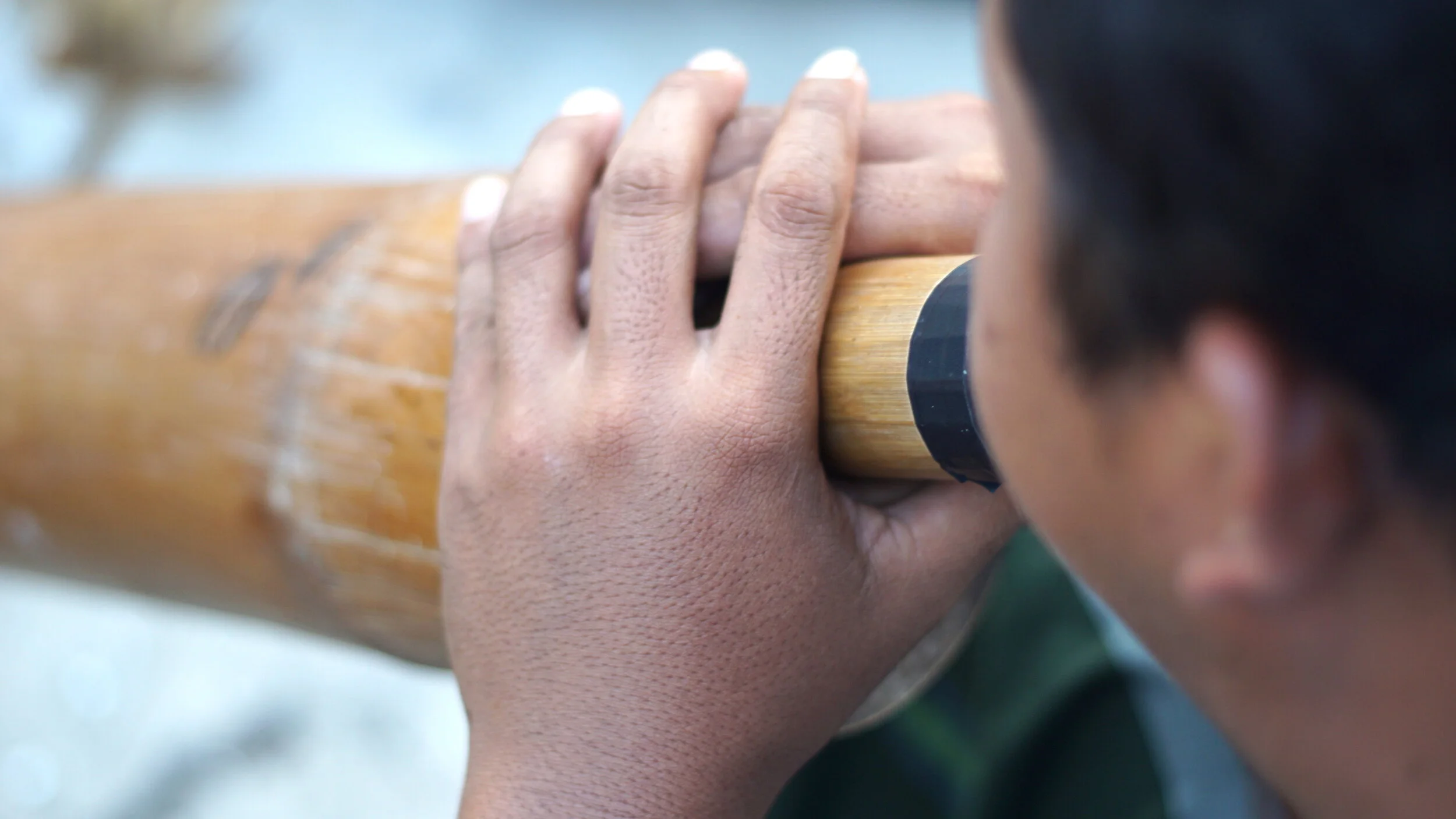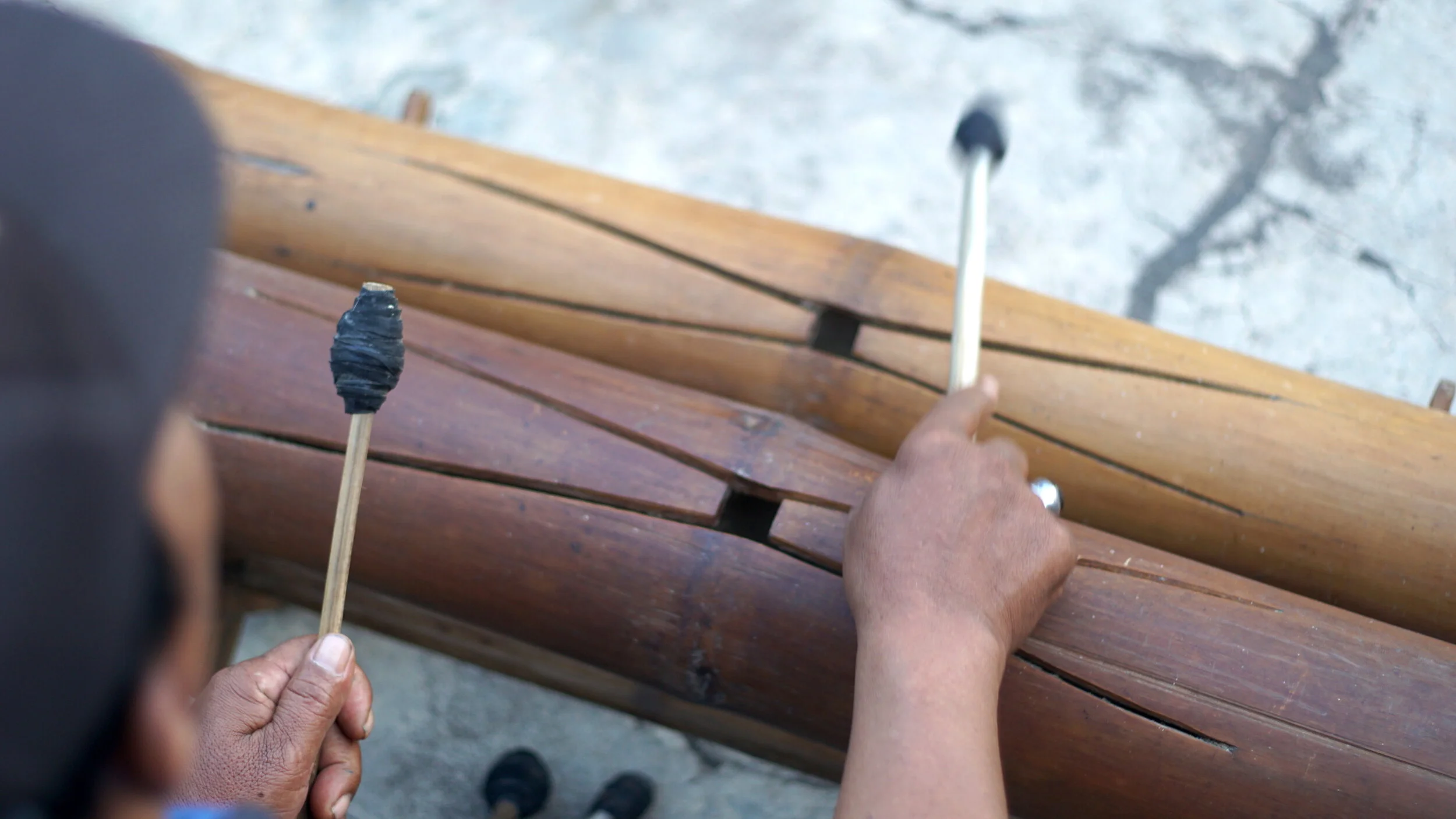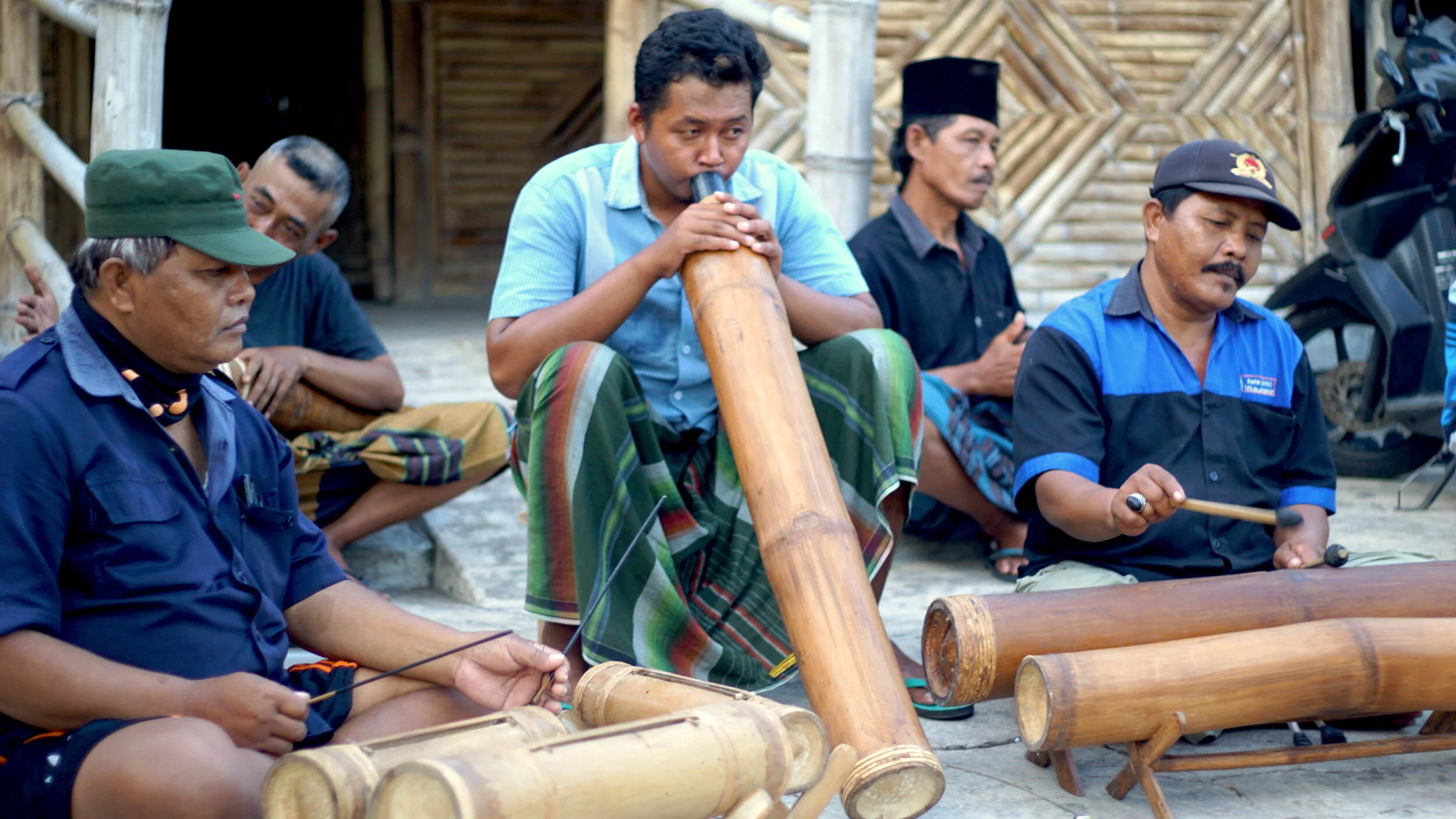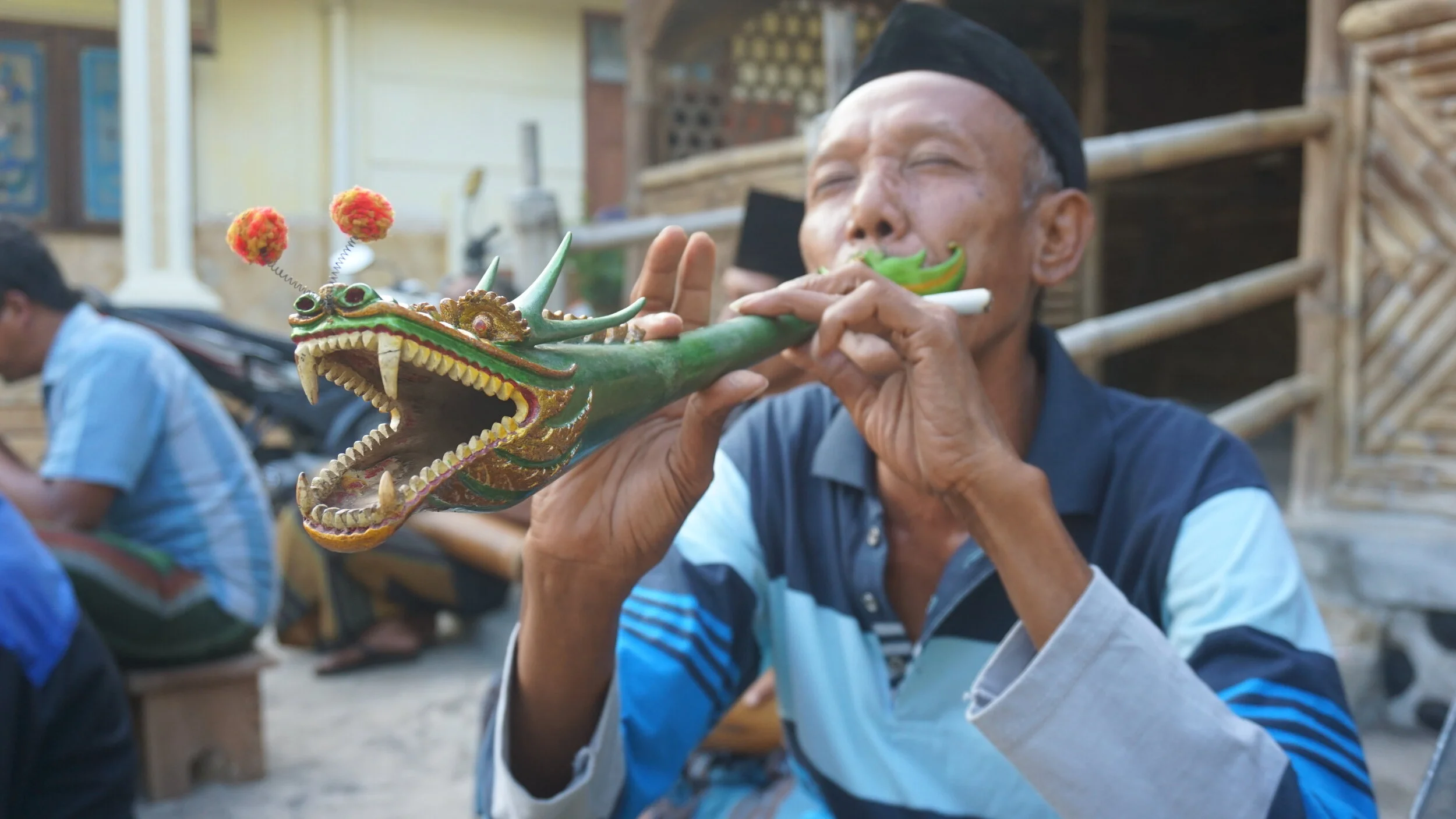Sounds of Madurese East Java, Pt. 2: Serbung
This is Part 2 in the Sounds of Madurese East Java series, a collection of posts exploring the rich sound worlds of the Madurese diaspora in “mainland” East Java. To read Part 1, including the introduction to this series, click here.
Location: Ds. Jatimulyo, Kec. Kunir, Kab. Lumajang, East Java
Sound: Serbung
The “blown gong” (gong tiup) is one of my favorite musical terms in Java. If you haven’t seen one, the name is bound to provoke some head-scratching - a gong can be struck, hit, banged even...but blown? You’ve gotta think a bit more out of the box, though...in these parts, a gong ain’t just a circular metal disk.
In the case of serbung and other “blown gong” traditions, the “gong” in question is a set of nested bamboo tubes, one thin and open at both ends, the other wide and closed off by the bamboo’s natural node at the bottom. Purse your lips and blow into the thinner one like a didgeridoo, and you’ll get a low and resonant, some would even say gong-like, tone. For folk ensembles across this part of Indonesia, that gong-ness is good enough - gongs can be powerful, sacred instruments, sure, but they’re also expensive or simply superfluous depending on the circumstances. What’s important is that you’ve got that musical marker, a resonant thrum to divide the cycles of rhythm and sound.
If you’ve dug through the Aural Archipelago archives, you may have come across these instruments before - the songah ensemble of Sumedang, West Java, features many, as do the gondolio and angklung buncis groups I recorded in Banyumas, Central Java. Heading over to the island of Madura, the early Dutch ethnomusicologists Anne Brandts Buys-Van Zijp and J.S. Brandts Buys documented the instrument, called serbung or juwer, in ensembles across the island in the 1920’s. Madura, the Brandts Buys’s documented with incredible thoroughness, was just as full of bamboo music as Java, a wonderland of mouth harps, bamboo zithers and slit drums.
This story doesn’t stay in Madura, though. As Mrs. and Mr. Brandts Buys were roaming across Madura in the 1920’s, a young Madurese man named Abdurahman was settling down in Jatimulyo, a seaside village on the southern coast of Lumajang in East Java. Mbah Eroh, as he’s remembered now, had just moved from his hometown in Probolinggo, a neighboring regency heavily populated by the Madurese diaspora, and he’d brought a blown gong or two with him.
From the Brandts Buys collection, a Madurese saronen ensemble with serbung second from the left.
The Madurese are great lovers of ensemble music, and you’d never play a gong alone. Gathering bamboo from the nearby groves, Mbah Eroh formed an entire ensemble out of the material, the whole of which he also called serbung (a name, Mbah Eroh liked to explain, which came from the Madurese serepeh bumbung, or “blown bamboo.”) With the serbung as the anchor, Mbrah Eroh added ronang, struck single-string idiochord zithers played in a trio to replicate the set of three small horizontal gongs the Madurese call kenong tello’. In place of the kendhang barrel drums often used in Madurese ensembles, Mbah Eroh subbed in two unique instruments. The first is kendang keplak (literally “slapped drum”), a bamboo drum with a betel nut bark head that hangs loose on the end like the paper tab on a Pringles can, ready to be slapped. The second is kendang pukul (literally “struck drum”), a special kind of slit or tongue drum made by carving an “X” into the body of a length of bamboo and striking the “tongues” and slit edges with bamboo mallets to get a great range of drum-like sounds.
With this core percussive base, you could add a saronen double reed to bring in melody and allow the serbung to borrow from the saronen-led kenong tello’ repertoire, or you could play slower pieces with the classic high-pitched poetic verse called kejhung. The serbung ensemble soon caught on in Jatimulyo, playing to accompany everything from harvest rituals to circumcision ceremonies and weddings. According to oral history in Jatimulyo, the music remained popular for decades, even being played for the Japanese who occupied Java during World War II.
As with many other musical traditions, however, serbung eventually became a casualty of the unrest of 1965, when mass killings of suspected communists swept across the country. The arts had been a favored tool of many communist and labor groups in the country, so many musicians and artists were forced to outright abandon their arts for fear of being branded a communist and executed. Other than a brief revival in the 80’s when Mak Eroh’s serbung group was invited to represent Lumajang on TVRI, Indonesia’s state TV channel, the serbung tradition was snuffed out for nearly forty years.
The story of serbung’s latest revival in 2018 at first glance seems unromantic, beginning with local Lumajang Tourism Department folks digging around for a unique artform in the southern district that could be held up as a symbol of the area’s ethnic and cultural diversity. I tend to look on such initiatives with a dose of skepticism, as traditions often end up being propped up more for the sake of politics than for nobler reasons like the strengthening of heritage or the joy of art itself. On the other hand, driven by the right people with an understanding of art, this kind of sudden revival can be a chance to rekindle dormant musical spirits and reclaim nearly lost histories while having fun in the process.
I think Lumajang found the man for the job in Mas Alfian. A young drum teacher and Lumajang local with a pure love of music, Mas Alfian started out playing in emo bands, later becoming “one of two bucket drummers in Indonesia.” It was Alfian who first caught word of a lost tradition of blown gongs and bamboo music in Lumajang, and it was Alfian who headed to the seaside village of Jatimulyo, finally tracking down the grandson of the late Mak Eroh. Recognizing the value of the music, Alfian encouraged Mak Eroh’s descendants to summon the instruments back into being again, building new serbung, ronang, and both types of bamboo kendang from scratch to be played once more for the first time in decades.
Serbung’s 21st century revival started off with a bang: the group and their brand new yet ancient instruments played a big government-sponsored arts festival in December 2018, and in 2019 Alfian managed to secure some kind of sponsorship from a major cigarette company, Djarum (the people of Jatimulyo, some of the musicians explained, are loyal Djarum smokers). This infusion of cigarette money allowed them to perform multiple times that year, and with each performance the energy seemed to grow.
When I visited Jatimulyo in June 2021, even Mas Alfian had to admit that the energy was waning. Of course there was the issue of the coronavirus pandemic, which had put a standstill to performing arts across Indonesia for nearly a year and a half - that had certainly taken the wind out of their sails. But a deeper issue, one with which many such revival movements have to reckon, is that the serbung group is still in search of a deeper purpose. What is the value of a musical tradition that only plays as perfunctory local color at government festivals? If music isn’t being played in the community, for the community, as it once was...how “revived” is it, really?
In 2018, on my first trip to Madura proper, I stopped by the village of Madegan in Sampang Regency. I’d heard that Madegan was home to a nearly identical ensemble of bamboo instruments called ba’beng (after the ronang-like tube zither considered central to the ensemble.) The story of ba’beng was eerily similar to what I’d later hear in Jatimulyo: it was a functionally extinct tradition that had been revived by the local government and momentarily embraced as a unique local tradition. However, the state of the music was, to be honest, dire: the musicians hadn’t played in years, the instruments gathering dust since the last government-sponsored festival. When they finally brushed off their instruments and played, it was so lackluster as to be a little bit sad - I even turned off my recorder about halfway through.
In comparison, the Jatimulyo crew had a bit more verve, and the music (and its future!) is better for it. While the instruments themselves were just a few years old, the musicianship on display showed a lifetime of Madurese music internalized and now finally expressed. Pak Sawar’s syncopated beatings on the kendang pukul were fresh, and the paparekan verses that Pak Misdi pulled out of his back pocket were pure poetry, literally (a taste, with the classic mix of obscure rural metaphor and heart-on-sleeve romance: “Serkeseran ma’ obi manis, jang lajangan daunna nangka, kerpekkeran sambi nangis, jang bajangan sangghu dhika”: “Tugging at sweet yams, kites of jackfruit leaves/ thinking while I weep, I'm already in love/In every shadow I see you.") It’s these bits that make the music of serbung really shine, and its these details that are, in large part, the real treasures worth preserving. The blown gongs and slapped drums may draw us in, but, I hope, it is these more obscure charms that will help serbung make a lasting impression on the next generation.
+++
To get a look at the behind the scenes of the serbung recording sesh, check out the Behind the Scenes IG Story archived at @auralarchipelago: Behind The Scenes, Pt. 1, Behind the Scenes, Pt. 2
Special thanks to Alfian for his wonderful work and support in this project - he is a true inspiration, and a model for the next generation of anak Lumajang.
Serbung Jatimulyo are:
Pak Nisad - ronang
Pak Satab - kendang keplak
Samsul - serbung
Pak Misdi - kendang keplak, kejhung
Pak Sawar - kendang pukul
Pak Mino - saronen

